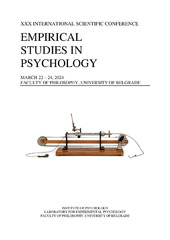Приказ основних података о документу
„Do you even listen to me?“: Phases in the development of couples’ contact episode in the initial stage of couple therapy
| dc.creator | Jovanović, Dušanka | |
| dc.creator | Grbić, Sanja | |
| dc.date.accessioned | 2024-03-18T18:13:58Z | |
| dc.date.available | 2024-03-18T18:13:58Z | |
| dc.date.issued | 2024 | |
| dc.identifier.isbn | 978-86-6427-284-1 | |
| dc.identifier.uri | http://reff.f.bg.ac.rs/handle/123456789/6284 | |
| dc.description.abstract | From the perspective of the dialogic approach, the initial stage of partner therapy is characterized by monitoring the dialogic exchange of partners, to identify the characteristics of relational dynamics that facilitate or hinder constructive exchange. These relational microprocesses, however, are largely unexplored. The goal of this exploratory study (as a part of larger research) is to map in-session couple dynamics in the initial stage of therapy. The question that guided us was: what formally defined phases characterize the development of partner interaction? The participants were six heterosexual couples (29–45 years old, ≥2 years together, 5 without children). The data was collected through videotaping the second therapy session. The material for the analysis were contact episodes: couple interaction regarding the self-selected topic, during which the therapist entered the observer role. Thematic analysis was applied by the authors, with the interpretation based on Martin Buber’s dialogical approach and theory of Gestalt therapy. Five themes, i.e., phases of the contact episode were identified, with some variations of these phases being more and some less supportive of constructive exchange. The first phase is The emergence of the need, in which the couple defines the individual or relational needs and the obstacles to their realization. Variations concern participation in problem definition (one-sided or mutual), way of defining (as relational or as personal), and communication style (e.g., criticizing). The second phase is the Habitual attempt to satisfy the needs and concerns couple’s usual problem-solving style, which can be less constructive (e.g., blaming, fruitless confrontation), or more constructive (communicating personal shortcomings and boundaries). The third stage is Impasse, in which repeated unsuccessful attempts at resolution lead to a feeling of being stuck. This could appear in the form of polarization of positions, or the form of resignation and withdrawal. The fourth stage is Novelty and regression, in which a constructive change appears briefly before it is quickly lost by returning to previous communication patterns. The fifth stage is a Constructive dialogical relationship, in which the novelty introduced by one partner brings either calmness and reflection, or empathy and validation of the other partner. The paper extends the efforts of the integrative family therapists regarding the process diagnostic in the initial stage of couple therapy, by offering tools that could be useful in the shorter time frame – within one therapy session. | sr |
| dc.language.iso | en | sr |
| dc.publisher | Belgrade: Institute of Psychology, Laboratory for Experimental Psychology, Faculty of Philosophy, University of Belgrade | sr |
| dc.relation | This research is funded by the Ministry of Science, Technological Development and Innovation of the Republic of Serbia (Contract No. 451-03-66/2024-03/200163) | sr |
| dc.rights | openAccess | sr |
| dc.rights.uri | https://creativecommons.org/licenses/by/4.0/ | |
| dc.source | Book of Abstracts, XXIX International Scientific Conference Empirical Studies in Psychology, Faculty of Philosophy, University of Belgrade | sr |
| dc.subject | couple therapy | sr |
| dc.subject | in-session couple dynamics | sr |
| dc.subject | dialogical approach | sr |
| dc.subject | qualitative study | sr |
| dc.subject | gestalt therapy | sr |
| dc.title | „Do you even listen to me?“: Phases in the development of couples’ contact episode in the initial stage of couple therapy | sr |
| dc.type | conferenceObject | sr |
| dc.rights.license | BY | sr |
| dc.citation.spage | 134 | |
| dc.identifier.fulltext | http://reff.f.bg.ac.rs/bitstream/id/16022/bitstream_16022.pdf | |
| dc.identifier.rcub | https://hdl.handle.net/21.15107/rcub_reff_6284 | |
| dc.type.version | publishedVersion | sr |

